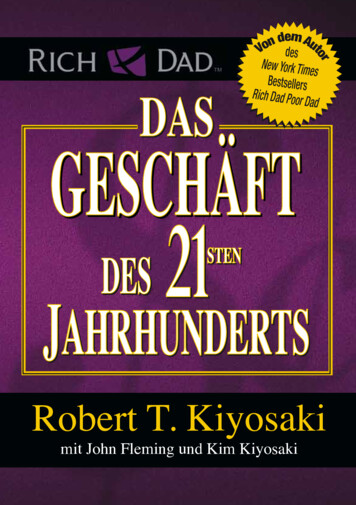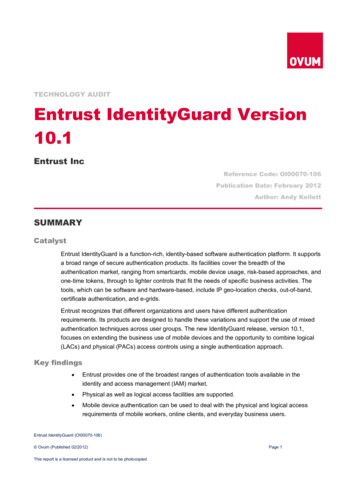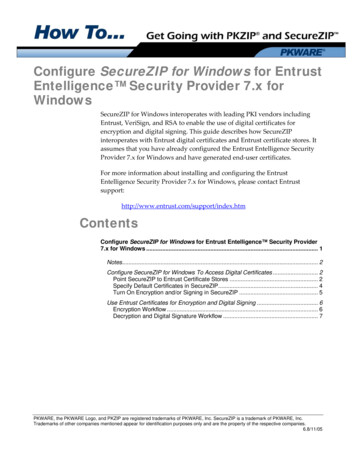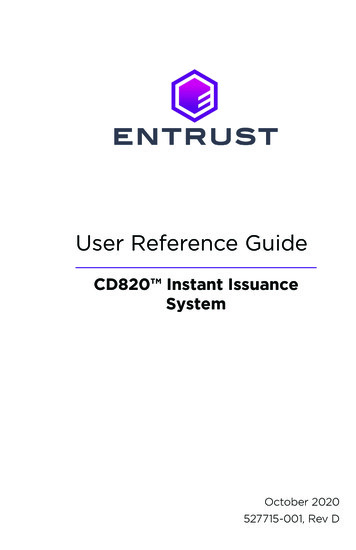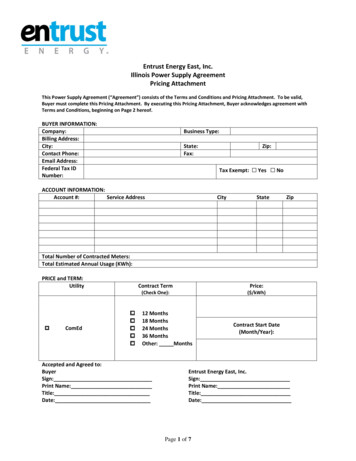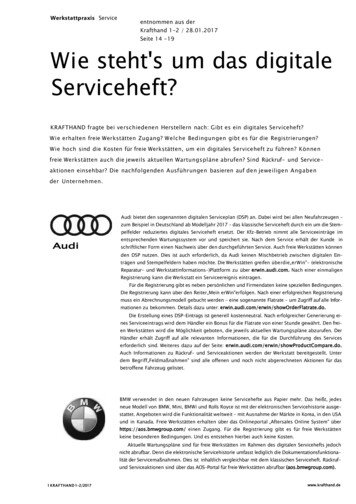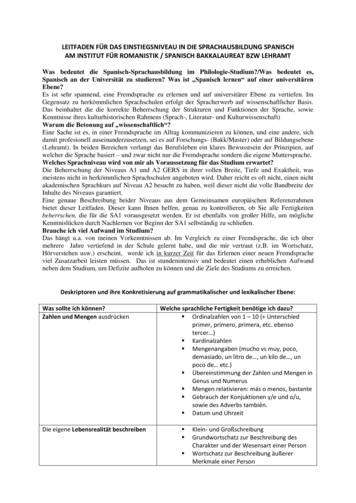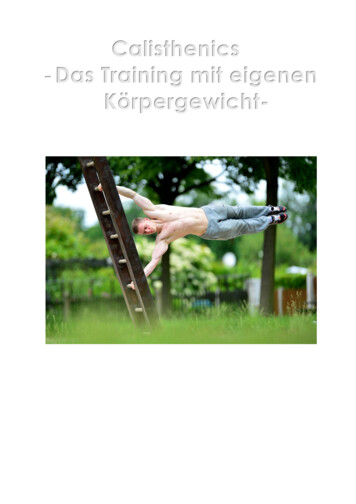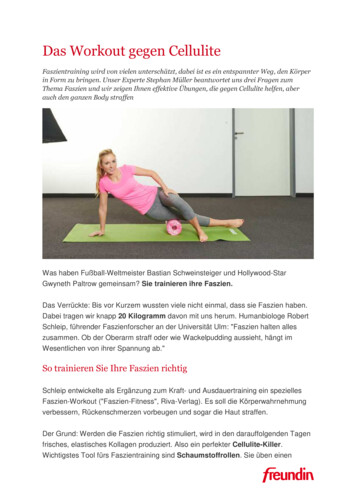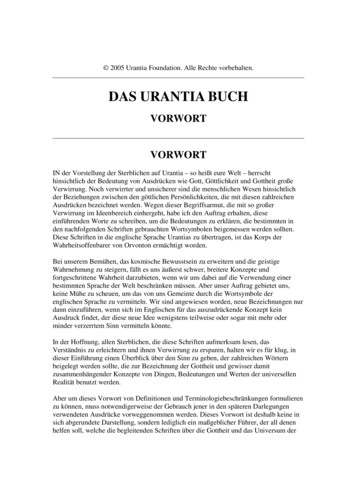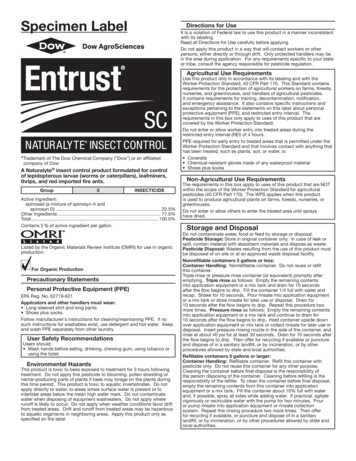
Transcription
Specimen LabelDirections for UseIt is a violation of Federal law to use this product in a manner inconsistentwith its labeling.Read all Directions for Use carefully before applying.Do not apply this product in a way that will contact workers or otherpersons, either directly or through drift. Only protected handlers may bein the area during application. For any requirements specific to your stateor tribe, consult the agency responsible for pesticide regulation.Agricultural Use Requirements Trademark of The Dow Chemical Company (“Dow”) or an affiliatedcompany of DowA Naturalyte insect control product formulated for controlof lepidopterous larvae (worms or caterpillars), leafminers,thrips, and red imported fire ants.Group5INSECTICIDEActive Ingredient:spinosad (a mixture of spinosyn A andspinosyn D). 22.5%Other Ingredients. 77.5%Total. 100.0%Contains 2 lb of active ingredient per gallon.Listed by the Organic Materials Review Institute (OMRI) for use in organicproduction.For Organic ProductionPrecautionary StatementsPersonal Protective Equipment (PPE)EPA Reg. No. 62719-621Applicators and other handlers must wear: Long-sleeved shirt and long pants Shoes plus socksFollow manufacturer's instructions for cleaning/maintaining PPE. If nosuch instructions for washables exist, use detergent and hot water. Keepand wash PPE separately from other laundry.User Safety RecommendationsUsers should: Wash hands before eating, drinking, chewing gum, using tobacco orusing the toilet.Environmental HazardsThis product is toxic to bees exposed to treatment for 3 hours followingtreatment. Do not apply this pesticide to blooming, pollen-shedding ornectar-producing parts of plants if bees may forage on the plants duringthis time period. This product is toxic to aquatic invertebrates. Do notapply directly to water, to areas where surface water is present or tointertidal areas below the mean high water mark. Do not contaminatewater when disposing of equipment washwaters. Do not apply whererunoff is likely to occur. Do not apply when weather conditions favor driftfrom treated areas. Drift and runoff from treated areas may be hazardousto aquatic organisms in neighboring areas. Apply this product only asspecified on the label.Use this product only in accordance with its labeling and with theWorker Protection Standard, 40 CFR Part 170. This Standard containsrequirements for the protection of agricultural workers on farms, forests,nurseries, and greenhouses, and handlers of agricultural pesticides.It contains requirements for training, decontamination, notification,and emergency assistance. It also contains specific instructions andexceptions pertaining to the statements on this label about personalprotective equipment (PPE), and restricted entry interval. Therequirements in this box only apply to uses of this product that arecovered by the Worker Protection Standard.Do not enter or allow worker entry into treated areas during therestricted entry interval (REI) of 4 hours.PPE required for early entry to treated areas that is permitted under theWorker Protection Standard and that involves contact with anything thathas been treated, such as plants, soil, or water, is: Coveralls Chemical-resistant gloves made of any waterproof material Shoes plus socksNon-Agricultural Use RequirementsThe requirements in this box apply to uses of this product that are NOTwithin the scope of the Worker Protection Standard for agriculturalpesticides (40 CFR Part 170). The WPS applies when this productis used to produce agricultural plants on farms, forests, nurseries, orgreenhouses.Do not enter or allow others to enter the treated area until sprayshave dried.Storage and DisposalDo not contaminate water, food or feed by storage or disposal.Pesticide Storage: Store in original container only. In case of leak orspill, contain material with absorbent materials and dispose as waste.Pesticide Disposal: Wastes resulting from the use of this product mustbe disposed of on site or at an approved waste disposal facility.Nonrefillable containers 5 gallons or less:Container Handling: Nonrefillable container. Do not reuse or refillthis container.Triple rinse or pressure rinse container (or equivalent) promptly afteremptying. Triple rinse as follows: Empty the remaining contentsinto application equipment or a mix tank and drain for 10 secondsafter the flow begins to drip. Fill the container 1/4 full with water andrecap. Shake for 10 seconds. Pour rinsate into application equipmentor a mix tank or store rinsate for later use or disposal. Drain for10 seconds after the flow begins to drip. Repeat this procedure twomore times. Pressure rinse as follows: Empty the remaining contentsinto application equipment or a mix tank and continue to drain for10 seconds after the flow begins to drip. Hold container upside downover application equipment or mix tank or collect rinsate for later use ordisposal. Insert pressure rinsing nozzle in the side of the container, andrinse at about 40 psi for at least 30 seconds. Drain for 10 seconds afterthe flow begins to drip. Then offer for recycling if available or punctureand dispose of in a sanitary landfill, or by incineration, or by otherprocedures allowed by state and local authorities.Refillable containers 5 gallons or larger:Container Handling: Refillable container. Refill this container withpesticide only. Do not reuse this container for any other purpose.Cleaning the container before final disposal is the responsibility ofthe person disposing of the container. Cleaning before refilling is theresponsibility of the refiller. To clean the container before final disposal,empty the remaining contents from this container into applicationequipment or a mix tank. Fill the container about 10% full with waterand, if possible, spray all sides while adding water. If practical, agitatevigorously or recirculate water with the pump for two minutes. Pouror pump rinsate into application equipment or rinsate collectionsystem. Repeat this rinsing procedure two more times. Then offerfor recycling if available, or puncture and dispose of in a sanitarylandfill, or by incineration, or by other procedures allowed by state andlocal authorities.
Pests and Application Rates: D o not apply more than a total of 29 fl oz of Entrust SC (0.45 lb aispinosad) per acre per crop for all methods of application, includingfoliar, soil and seed treatment uses. M aximum Number of Applications: Do not make more than threeapplications per calendar year. D o not apply to citrus nurseries or citrus in greenhouses.Entrust SC(fl oz/acre)4-8Pestsclimbing cutwormsEuropean grapevine mothgrape berry mothgrape leaffoldergrape leaf skeletonizerlight brown apple mothomnivorous leafrollerorange tortrixredbanded leafrollerthripsFruit, Pome (Crop Group 11-10)11 Apple; Azarole; Crabapple; Loquat; Mayhaw; Hook. & Arn.; Medlar;Pear; Pear, Asian; Quince; Quince, Chinese; Quince, Japanese; Tejocote;Cultivars, varieties and/or hybrids of these.Pests and Application Rates:Entrust SCPests(fl oz/acre)4 - 10leafminers1spotted tentiformwestern tentiformapple maggot (suppression)6 - 10codling mothEuropean grapevine mothleafrollersoblique-bandedpandemislight brown apple mothoriental fruit moththrips1tufted apple budmoth1 Control of leafminers and thrips may be improved with the addition ofan adjuvant to the spray mixture. See Use of Adjuvants section underMixing Directions.Application Timing: Treat when pests appear, targeting eggsat hatch or small larvae. Heavy infestations may require repeatapplications, but follow resistance management guidelines. Consultyour Dow AgroSciences representative, extension service specialist,certified crop advisor or your state agricultural experiment station for anyadditional local use recommendations for your area.Application Rate: Carefully adjust equipment and spray volume to assurethorough uniform coverage of infested parts of the crop. Use a higherrate in the rate range for larger larvae or moderate to severe infestationsand/or larger plant volume.Resistance Management: Do not make more than two consecutiveapplications of Group 5 insecticides (spinetoram and spinosad). Ifadditional treatments are required after two consecutive applications ofGroup 5 insecticides, rotate to another class of effective insecticides for atleast one application. Consult your local Dow AgroSciences representative,extension specialist, certified crop advisor, or state agricultural experimentstation for information on alternative effective products to use in your area.Restrictions: Preharvest Interval: Do not apply within 7 days of harvest. Minimum Treatment Interval: Do not make applications less than5 days apart. Do not apply more than a total of 29 fl oz of Entrust SC (0.45 lb aispinosad) per acre per season west of the Rocky Mountains, and nomore than 23 fl oz of Entrust SC (0.36 lb ai spinosad) per acre perseason east of the Rocky Mountains for all methods of application,including foliar, soil and seed treatment uses. Maximum Number of Applications: Do not make more than fiveapplications per calendar year.Application Timing: Optimal timing for leafminers and leafrollers mayvary between species and geographic location. For leafminers, monitorthe moth flights and infestation densities of both the sap-feeding andtissue-feeding stage. For optimum control, treat at first appearance ofleaf mining activity. For leafrollers, monitor the moth flights and theinfestation densities of the larval stages. Repeat application as necessaryto maintain control. Closely follow regional spray recommendations forcodling moth and oriental fruit moth treatments based upon biofix datesand pheromone trap catches. Codling moth and oriental fruit mothlarvae must be controlled before they penetrate the fruit. Codling mothand oriental fruit moth applications will provide control for no more than10 days. Repeat application as necessary to maintain control. Consultwith your Dow AgroSciences representative, state agricultural experimentstation, certified pest control advisor or extension specialist for specificapplication timings in your area.Application Rate: The amount of Entrust SC applied per acre will dependupon tree size and pest pressure. Use a lower rate in the rate range forlight infestations and/or small trees and a higher rate in the rate range forheavy infestations and/or larger trees.Resistance Management: Do not make more than three consecutiveapplications of Group 5 insecticides (spinetoram and spinosad)within a crop season. If additional treatments are required after threeconsecutive applications of Group 5 insecticides, rotate to anotherclass of effective insecticides for at least one application. Consult yourlocal Dow AgroSciences representative, extension specialist, certifiedcrop advisor, or state agricultural experiment station for information onalternative effective products to use in your area. Do not treat consecutivegenerations of codling moth, oriental fruit moth, and leafrollers.Restrictions: P reharvest Interval: Do not apply within 7 days of harvest. M inimum Treatment Interval: Do not make applications less than10 days apart. D o not apply more than a total of 29 fl oz of Entrust SC (0.45 lb aispinosad) per acre per crop for all methods of application, includingfoliar, soil and seed treatment uses. D o not apply more than three sprays targeted at leafrollersper season. M aximum Number of Applications: Do not make more than fourapplications per calendar year.Fruit, Stone (Crop Group 12-12)11 Stone fruits (crop group 12-12) Apricot; Apricot, Japanese; Capulin;Cherry, black; Cherry, Nanking; Cherry, sweet; Cherry, tart; Jujube,Chinese; Nectarine;Peach; Plum; Plum, American; Plum, beach;Plum, Canada; Plum, cherry; Plum, Chickasaw; Plum, Damson; Plum,Japanese; Plum, Klamath; Plumcot; Plum, prune; Sloe; cultivars,varieties, and/or hybrids of these.Pests and Application Rates:PestsEntrust SCDilute Spray(fl oz/acre)(fl oz/100 gal)4-81.3 – 2.7cherry fruit fly, such as:black cherryeastern cherrywestern cherry fruit fly(suppression)European grapevine mothgreen fruitwormlepidopteran leafminers1 such as:spotted tentiformwestern tentiformleafrollers, such as:fruit treeoblique-bandedpandemisredbandedvariegatedlight brown apple mothoriental fruit mothpeach twig borerthrips1western cherry fruit fly1 Control of leafminers and thrips may be improved with the addition ofan adjuvant to the spray mixture. See Use of Adjuvants section underMixing Directions.Fruit, Small, Vine Climbing, except fuzzy kiwifruit(Subgroup 13-07F)11 Amur river grape; gooseberry; grape; kiwifruit, hardy; Maypop;schisandra berry; cultivars varieties, and/or hybrids of these.9Specimen Label Revised 06-13-17
Mixing DirectionsStorage and Disposal (Cont.)Always shake well before use. Avoid freezing.Nonrefillable containers 5 gallons or larger:Container Handling: Nonrefillable container. Do not reuse or refillthis container.Triple rinse or pressure rinse container (or equivalent) promptly afteremptying. Triple rinse as follows: Empty the remaining contents intoapplication equipment or a mix tank. Fill the container 1/4 full with water.Replace and tighten closures. Tip container on its side and roll it backand forth, ensuring at least one complete revolution, for 30 seconds.Stand the container on its end and tip it back and forth several times.Turn the container over onto its other end and tip it back and forthseveral times. Empty the rinsate into application equipment or a mixtank or store rinsate for later use or disposal. Repeat this procedure twomore times. Pressure rinse as follows: Empty the remaining contentsinto application equipment or a mix tank and continue to drain for10 seconds after the flow begins to drip. Hold container upside downover application equipment or mix tank or collect rinsate for later use ordisposal. Insert pressure rinsing nozzle in the side of the container, andrinse at about 40 psi for at least 30 seconds. Drain for 10 seconds afterthe flow begins to drip. Then offer for recycling if available, or punctureand dispose of in a sanitary landfill, or by incineration, or by otherprocedures allowed by state and local authorities.Application Rate Reference TableApplication Rate ofEntrust SC(fl oz/acre)1.5346810Active IngredientEquivalent(lb ai/acre)0.0230.0470.0620.0940.1250.156Acres per Gallon ofEntrust SC854332211613Entrust SC - Alone: Fill the spray tank with water to about 1/2 of therequired spray volume. Start agitation and add the required amount ofEntrust SC. Continue agitation while mixing and filling the spray tank tothe required spray volume. Maintain sufficient agitation during applicationto ensure uniformity of the spray mix. Do not allow water or spray mixtureto back-siphon into the water source.Entrust SC - Tank Mix: When tank mixing Entrust SC with othermaterials, a compatibility test (jar test) using relative proportions of thetank mix ingredients should be conducted prior to mixing ingredients inthe spray tank. If foliar fertilizers are used, the jar test should be repeatedwith each batch of fertilizer utilizing the mixing water source. Do notuse acidifying buffering agents in tank mixes with Entrust SC. Vigorous,continuous agitation during mixing, filling and throughout application isrequired for all tank mixes. Sparger pipe agitators generally provide themost effective agitation in spray tanks. To prevent foaming in the spraytank, avoid stirring or splashing air into the spray mixture.Mixing Order for Tank Mixes: Fill the spray tank with water to 1/4 to1/3 of the required spray volume. Start agitation. Add differentformulation types in the order indicated below, allowing time for completedispersion and mixing after addition of each product. Allow extradispersion and mixing time for dry flowable products.Add different formulation types in the following order:1. Water dispersible granules2. Wettable powders3. Entrust SC and other aqueous suspensionsMaintain agitation and fill spray tank to 3/4 of total spray volume.Then add:4. Emulsifiable concentrates and water-based solutions5. Spray adjuvants, surfactants and oils6. Foliar fertilizersFinish filling the spray tank. Maintain continuous agitation during mixing,final filling and throughout application. If spraying and agitation mustbe stopped before the spray tank is empty, the materials may settle tothe bottom. Settled materials must be resuspended before spraying isresumed. A sparger agitator is particularly useful for this purpose.Premixing: Dry and flowable formulations may be premixed with water(slurried) and added to the spray tank through a 20 to 35 mesh screen.This procedure assures good initial dispersion of these formulation types.Spray Tank pH: A spray tank pH between 6.0 and 9.0 is suggested toachieve maximum performance of Entrust SC. If the water source isoutside of this pH range, or if tank mixing other pesticides, adjuvants,or foliar nutrients will cause the pH to fall outside of this range, consideradjusting the spray tank pH to be between 6.0 and 9.0 before addingEntrust SC To do this, add all other tank mix components first, thencheck the spray tank pH, adjust if desired, and then add Entrust SC.If you require additional information on how to adjust spray tank pH,contact your Dow AgroSciences representative.Use of Adjuvants: Adjuvants may be used to improve the control ofleafminers and thrips in situations where achieving uniform plant coverageis difficult (such as closed crop canopy or dense foliage), or penetrationinto waxy leaf surfaces is required for pest control. Use only adjuvant products labeled for agricultural use and followthe manufacturer’s label directions. A nominal concentration of 1 to2 quarts per 100 gallons (0.25 to 0.5% v/v) is generally sufficient. For leafminers and thrips, emulsified crop oils or methylated crop oilplus organosilicone combination products are recommended. When using adjuvants, always conduct a jar test to determine thecompatibility of the various components in the spray mixture. Cropsafety should be evaluated in a small area of the crop whenever there isa significant change in spray mixture ingredients or source of water forthe spray mixture. Do not use diesel fuel or pure mineral oil. A djuvants may require organic certification; consult your organic certifier.Product InformationEntrust SC is a Naturalyte insect control product for control of manyfoliage feeding pests including lepidoptera larvae (worms or caterpillars),Colorado potato beetles, leafminers and thrips infesting labeled crops.This product’s active ingredient, spinosad, is biologically derived fromthe fermentation of Saccharopolyspora spinosa, a naturally occurring soilorganism. Mix Entrust SC with water and apply as a foliar spray with aerialor ground equipment equipped for conventional insecticide spraying.Product Use PrecautionsIntegrated Pest Management (IPM) ProgramsEntrust SC is recommended for IPM programs in labeled crops. ApplyEntrust SC when field scouting indicates target pest densities have reachedthe economic threshold, i.e., the point at which the insect population mustbe reduced to avoid economic losses beyond the cost of control. Otherthan reducing the target pest species as a food source, Entrust SC doesnot have a significant impact on certain parasitic insects or the naturalpredaceous arthropod complex in treated crops, including big-eyed bugs,ladybird beetles, flower bugs, lacewings, minute pirate bugs, damselbugs, assassin bugs, predatory mites or spiders. The feeding activities ofthese beneficials will aid in natural control of other insects and reduce thelikelihood of secondary pest outbreaks. If Entrust SC is tank m
Entrust SC (fl oz/acre) leafminers1 spotted tentiform western tentiform 4 - 10 apple maggot (suppression) codling moth European grapevine moth leafrollers oblique-banded pandemis light brown apple moth oriental fruit moth thrips1 tufted apple budmoth 6 - 10 1Control of leafminers and thrip
